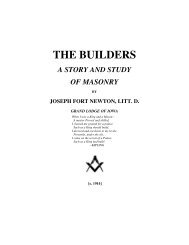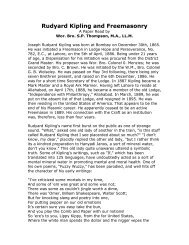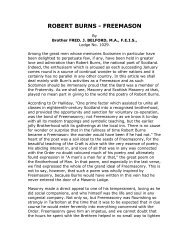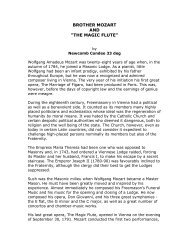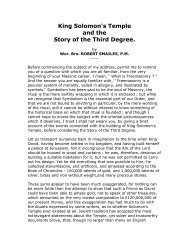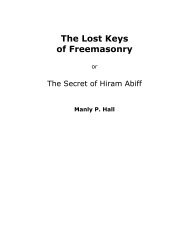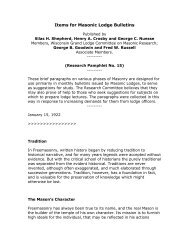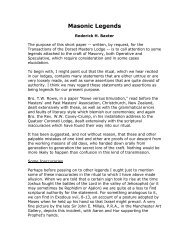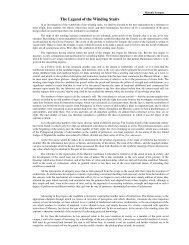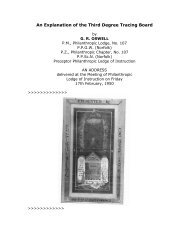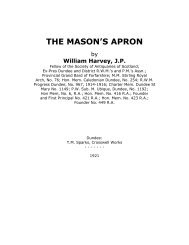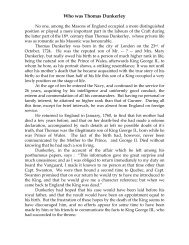Through the Key Hole - RoseCroix.org.au
Through the Key Hole - RoseCroix.org.au
Through the Key Hole - RoseCroix.org.au
You also want an ePaper? Increase the reach of your titles
YUMPU automatically turns print PDFs into web optimized ePapers that Google loves.
125<br />
WILLIAM MORGAN<br />
By Keith Stockley<br />
To most, if not all, Freemasons in <strong>the</strong> United States, <strong>the</strong> name of<br />
William M<strong>org</strong>an will conjure up some form of story although to <strong>the</strong><br />
remainder of <strong>the</strong> Masonic world he remains unknown.<br />
It is not my intention to repeat <strong>the</strong> many stories, myths and rumours<br />
that surround Captain William M<strong>org</strong>an, but merely to recount in<br />
abridged form, <strong>the</strong> circumstances in which he was <strong>the</strong> leading character,<br />
circumstances that resulted in <strong>the</strong> almost annihilation of Freemasonry<br />
in America.<br />
Whe<strong>the</strong>r he was ever a Freemason at all remains doubtful as no<br />
record of his raising or of his lodge membership has ever been<br />
found. After <strong>the</strong> disastrous results of what happened who would<br />
blame a lodge for erasing every reference to him in its records? It<br />
was certainly not <strong>the</strong> first time that such action had been taken by a<br />
lodge ( Benedict Arnold’s lodge took this action when it was learned<br />
that he had defected to <strong>the</strong> British).<br />
Maybe perhaps he was never a Mason at all? It is alleged that he<br />
did at one time receive Masonic charity which may perhaps be an<br />
indication that he was in fact a member?<br />
It is, however, a recorded fact that he was received into <strong>the</strong> Royal<br />
Arch in Western Star Chapter RAM No., 33 of LeRoy, Mew York. If<br />
he was not a Master Mason <strong>the</strong>n he could only have infiltrated this<br />
Order in <strong>the</strong> same way he apparently did when he lied his way into a<br />
Lodge in Rochester, however, apart from this reference to membership<br />
in <strong>the</strong> Royal Arch, <strong>the</strong>re is no evidence of his Masonic membership.<br />
In any event, he did indeed visit lodges, made Masonic speeches,<br />
took part in ritual work, but ultimately <strong>the</strong> regularity of his membership<br />
was questioned and he was excluded from some activities and<br />
this created within him an enmity of <strong>the</strong> craft. (It did cross my mind<br />
that to be “excluded” you must first be “included?”)<br />
51<br />
THE ROYAL SOCIETY– A SECRET<br />
MASONIC LODGE?<br />
By Keith Stockley<br />
There is no doubt that many Freemasons prominent in scientific<br />
and cultural circles of <strong>the</strong> day, were amongst <strong>the</strong> founders of <strong>the</strong><br />
Royal Society, perhaps all of <strong>the</strong>m were.<br />
In his book “The Invisible College”, <strong>au</strong>thor and historian Robert<br />
Lomas sets out to prove that <strong>the</strong> Society was indeed started by<br />
Freemasons and established according to Masonic principles.<br />
It is also very likely that initially, with <strong>the</strong> political and religious intolerance<br />
that was prevalent at that time, that <strong>the</strong> Royal Society<br />
was kept a secret until one of its founders, Sir Robert Moray ( a<br />
prominent Scottish Freemason), succeeded in obtaining <strong>the</strong> open<br />
support and approval of <strong>the</strong> king ( Charles II ) .<br />
It is believed that prior to its actual formation, a nucleus had been<br />
in existence for several years. As early as 1645 weekly meetings<br />
were being held in London by worthy persons who were interested<br />
in natural philosophy and o<strong>the</strong>r areas of human learning and it appears<br />
that <strong>the</strong>re is little doubt that <strong>the</strong>se worthy individuals were in<br />
fact <strong>the</strong> self-same group that established what John Boyle described<br />
as “The Invisible College”.<br />
The names of its founders, who attended <strong>the</strong> meeting on 28 November<br />
1660, at which it was decided to establish a “College for<br />
<strong>the</strong> promoting of Physico-Ma<strong>the</strong>maticall Experimentall Learning”<br />
were Lord Boucher, Robert Boyle, Sir Robert Moray, Sir Christopher<br />
Wren, Sir P<strong>au</strong>l Nielle, Dr John Wilkins and Messrs Petty, Ball,<br />
Rooke and Hill all of whom are considered to have been Freemasons.<br />
The Royal Society was to attract to its membership only outstanding<br />
men in various fields of learning, science and discovery<br />
and included Captain Cook, John Dryden, Elias Ashmole, Sir<br />
Isaac Newton, Francis Bacon and Benjamin Franklin allof whom<br />
were Freemasons.<br />
I believe that <strong>the</strong> very nature and substance of Freemasonry



